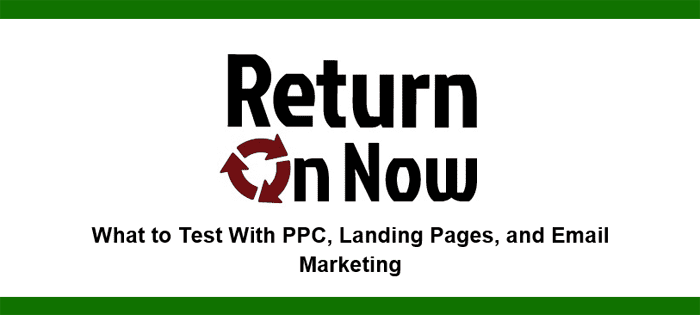We are nearing the end of the first month of 2015, and most of us should have a good idea of what new inbound marketing strategies we want to tackle this year. It always pays to review what we did in the previous year, analyze what worked and didn’t work, and come up with areas of improvement.
After having several conversations with clients and networking colleagues about testing and conversion rate optimization in the past few weeks, I thought I’d take a moment to do a brain dump of potential items to test. Since most of these conversations have centered around lead generation, the list of CRO testing items will focus on only three areas of internet marketing: landing pages, email marketing, and pay per click / search engine marketing.
Conversion Rate Optimization: What to Test
Note that CRO as I’m using it here goes beyond closing sales or even getting folks to sign up for a list. For the purposes of this post, consider conversion rate to be analogous to a prospect moving further down in your conversion funnel. In other words, if they click a link in a PPC ad or email, that counts as a conversion event along the path.
This is a laundry list of items intended to help give you new ideas. I managed to pull together over 50 of them. Of course, as with any good testing, you want to be very responsible about how you go about testing each element. The recommended approach is always to test one item at a time, collect the data, analyze it, choose a winner (when applicable), and then move on to the next element to test.
Why is this recommended? It’s all about being able to draw concrete conclusions. If you change three elements at at time, how can you be sure which element is driving any measurable changes in clicks and conversions? Is it one element or the interplay between each of them?
Yes, there are multivariate testing platforms, but those come with risks. Any good A/B Test will collect enough data to show statistical significance (i.e. a low margin of error), and you should never underestimate the volume of data needed to get to a statistically significant sample. When you throw in more than two tests at one time, the required data can increase exponentially.
If you plan to send a boatload of traffic to a landing page, multivariate might be a decent option. But for most small and mid-sized businesses, the volume won’t be there. So your test may have to run for a year or longer to collect enough data. Do you have years to figure this out? Most of us do not, so smaller and quicker tests are the right answer in most cases.
What to Test on Landing Pages
- Page Title – Wording, Tone, Urgency
- Headline / H1
- URL
- Meta Description (if targeting organic traffic)
- Header Image – Size, Colors, Inclusion of People or Objects, Product Imagery, etc.
- Key Call to Action
- Number of Calls to Action – One vs. Many
- Include Pricing or Not?
- Page Layout – e.g. What Goes Above the Fold vs. Below
- Directional Cues – Arrows, People Looking at CTA, etc.
- Credibility Block Contents – Testimonials? Reviews? Awards? Badges?
- Key Benefits
- Company Description
- Navigation Inclusion or Omission
- Form Length
- Form Design
- Call Tracking vs. Form Submissions – How Will You Track Conversions?
- Inclusion of Video or Not
- Use of a Slider or Not
- Buttons – size, shape, color, etc.
- Copy – long form vs. short form or bullets
- Different Layouts for Responsive UX
- Inclusion of Chat Features or Not
- Inclusion of Trust Logos or Not
What to Test in Emails
- Subject Line
- Sender Name – Brand Name or Person Name, and Which Person
- Sender Email Address – Generic (“info@…”) Vs. Personal (“tommy.landry@…”)
- Personalization
- Imagery
- Call to Action
- Number of Mentions of Call to Action
- Links for Call to Action – Text, Image, Button, etc.
- Layout
- Time and Date of Send
- Responsive Re-flow for Mobile – Which Layout Gets More Clicks?
What to Test for SEM / PPC
- Ad Group Structure
- Keyword Match Type Targeting
- Ad Headlines
- Ad Descriptions – Mix and Match Lines 1 and 2
- Ad Tone / Voice and Urgency
- Punctuation – Inclusion or Omission, or Irregular Usage (Within Guidelines)
- More Words Vs. More White Space in Ad Texts
- Call to Action
- Display URL – Subdomain vs. Subfolder, Use of Keyword or Not
- Destination Landing Page
- Include Pricing or Not?
- Geographic or Demographic Targeting
- Dynamic Keyword Insertion or Not
- Compare Results on Different Search Engines (e.g. AdWords vs. AdCenter)
- Dynamic Search Ads
- Extensions
- Bidding Strategies – Manual vs. Automatic, CPA-Based, or Other
Summary
Like I mentioned earlier in the post, these items are all worth testing on your own landing pages, emails, and PPC ads. Testing is crucial, because your “gut feel” may lead you down the wrong path. At the end of the day, a scientific approach is always warranted if it can help you squeeze out even a 5 percent improvement in clicks or conversions.
Did I miss any items that you’ve found useful for testing with any of these areas? If so, share in the comments below and I’ll take a look to see if it should be added. Thanks for reading.
Tommy Landry
Latest posts by Tommy Landry (see all)
- Local SEO Meets AEO and GEO: How AI Platforms Read Local Authority Signals - December 9, 2025
- What Is an SEO Proposal and What Should It Include? - December 2, 2025
- The Complete Guide to Dental SEO: How Dentists Can Attract More Local Patients Online - November 25, 2025





